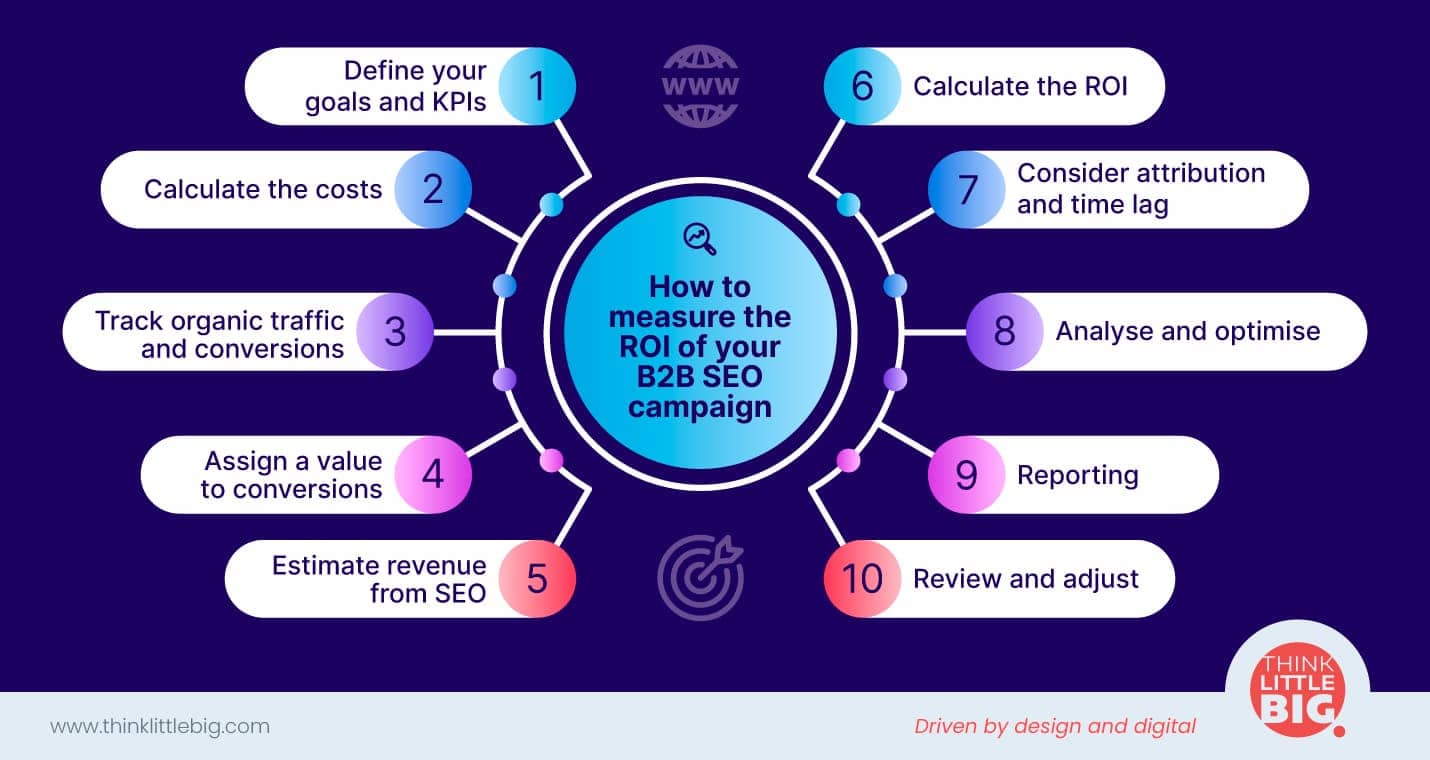Have you ever wondered whether your Business-to-Business Search Engine Optimisation (B2B SEO) efforts are paying off? With countless competing websites, running an SEO campaign without knowing how to measure its Return On Investment (ROI) can seem like shouting into the void. With so many factors to consider, measuring the ROI of your B2B SEO campaign can seem overwhelming, but it doesn’t have to be!
This blog will delve into the various tools and techniques available for effectively measuring the ROI of your B2B SEO campaigns. By following these steps and using the appropriate tools, you can obtain valuable insights into the effectiveness of your SEO strategy. It will allow you to make data-driven decisions, attract more qualified clients, and ultimately improve your bottom line.
Understanding the importance of measuring B2B SEO ROI
It is evident that SEO will stay in the digital landscape. Understanding the ROI of SEO is crucial as it provides a tangible measure of the financial benefits derived from your SEO initiatives. Not only does it validate your investment, but it also helps in directing resources towards the most impactful strategies.
In many cases, SEO can generate over 1000% more traffic compared to social channels. This highlights the importance of tracking SEO’s ROI to understand its effectiveness in driving business growth.
Why B2B SEO ROI Matters
ROI is a critical metric for businesses that resonates with marketers and entrepreneurs. It offers tangible proof of the value produced by SEO efforts. This data will help you in the following ways.
1. Budget allocation
With a proper estimate of the SEO campaign’s ROI, you can calculate the budget amount and secure necessary funding from your stakeholders.
2. Optimise marketing strategies
You can identify the areas within the SEO campaign that are performing well and adjust the strategy and resources accordingly while maximising the return.
3. Benchmark performance:
With this data, you can compare the ROI of your SEO strategy with that of your previous campaign or industry best practices to track the success rate and progress of the current campaign.
Challenges in measuring B2B SEO ROI
While marketers can reap many of SEO’s benefits, B2B digital marketing presents unique challenges in measuring ROI.
1. Longer sales cycles
B2B purchases, particularly for accounting services, frequently entail considered decision-making processes, which can complicate attributing conversions directly to a singular touchpoint such as an SEO campaign.
2. Complex buyer journeys
Before purchasing, potential customers interact with many digital channels, such as social media, referrals, and testimonials on the website, making it difficult to distinguish the SEO impact.
3. Indirect benefits
SEO indirectly enhances brand awareness by establishing thought leadership and various lead magnets that are challenging to quantify.

How to measure the ROI of your B2B SEO campaign
Here’s a step-by-step guide to effectively track and measure the ROI of your B2B SEO efforts:
1. Define your goals and KPIs
Setting clear goals for your SEO campaign is the first step for measuring its ROI. You need clear goals and proper KPIs to track the campaign’s progress and success. What are you aiming to achieve?
- Is your campaign goal to generate more high-quality leads?
- Are you aiming to boost your organic traffic through brand awareness?
- Or you maybe seeking higher conversion rates from your target customers?
Below are the common KPIs that will help you to track progress are as follows:
- Customer acquisition cost: The cost of acquiring a new customer through SEO efforts.
- Conversion rate: The percentage of website visitors who take a desired action, such as purchasing a product, downloading a case study or scheduling a consultation.
- Organic traffic: The number of visitors coming to your website from search engines.
- Quality of leads: Identifying leads with a higher potential to convert into paying clients.
Search Engine Optimisation frequently serves a vital function in the initial phases of the buyer journey, impacting awareness and consideration.
Since B2B buyer journeys typically encompass numerous touchpoints, using attribution models is crucial to assess which marketing channels contributed to conversions. Let’s explore three standard models:
- First-touch attribution: Assigns credit to the initial marketing channel that a user engages with.
Pros: It is simple to implement and provides insight into initial touchpoints.
Cons: It can overestimate the impact of early-stage channels, as later touchpoints may be more influential. - Last-touch attribution: Allocates the conversion to the final marketing channel a user interacts with before conversion.
Pros: It is easy to understand, as it focuses on the final interaction before conversion.
Cons: It may undervalue the importance of earlier-stage touchpoints that nurture the buyer. - Multi-touch attribution: Distributes credit among all touchpoints users encounter throughout their buyer journey.
Pros: Provides a more accurate view of the entire buyer journey, as it distributes credit fairly.
Cons: It can be complex to implement and analyse, as it requires more data.
Choosing the right attribution model depends on your specific business goals and marketing strategies. For example, if you’re focused on understanding which channels drive initial interest, first-touch attribution might be suitable. If you want to measure the impact of your final marketing efforts, last-touch attribution could be more relevant.
2. Calculate the costs
The next step is to calculate your total investments in the SEO campaign. Add all the costs related to all marketing channels and compile these expenses to get the actual amount for the SEO campaign.
Direct costs:
These expenses are directly associated with the SEO campaign and which would not have been incurred if you hadn’t undertaken it, for example:
- Costs for running the SEO tools for keyword research, backlink analysis tools, etc.
- Content creation costs for website copy, blogs, social media content, etc.
- Link building activities
- Cost of hiring an SEO consultant, content specialist, or agency for your SEO campaign.
- Remember the hours your team puts into SEO tasks, including keyword research, on-page optimisation, and content development.
- Reporting costs
Indirect costs:
Don’t forget to factor in overhead and operational expenses that support your SEO initiatives.
3. Track organic traffic and conversions
Organic search leads are, on average, 61% cheaper than leads generated through outbound methods. One significant step in measuring SEO performance is tracking conversions and organic traffic. Tools like Google Analytics (GA) can distinguish the nature of organic traffic and its correlation with conversions. With GA, you can monitor organic traffic sources, user behaviour on your site, and conversion rates from different website actions, like contact form submissions.
Beyond website traffic, you might track your target audience’s interactions with your website through different sales funnel stages. This will help you segment your traffic, such as paid or referral traffic.
4. Assign a value to conversions
To evaluate the effectiveness of your B2B SEO campaign, it’s crucial to assign a monetary value to each conversion. This approach will enable you to determine the return on investment (ROI) for your initiatives.
Start by estimating the revenue generated from each lead once they transition into a paying customer. If your business provides various services with distinct pricing models, calculating the average revenue for each service type can be beneficial.
In the B2B landscape, clients typically engage in long-term partnerships with your company. Thus, it’s vital to assess their cumulative revenue over time to gain a clearer understanding of the worth of each conversion. This is particularly significant for clients who utilise multiple services or refer your business to others.
Lastly, monitor the conversion rate of leads into paying customers. A high percentage of conversions suggests that your SEO efforts attract the right audience.
5. Estimate revenue from SEO
Now that you’ve calculated the value of each conversion, estimating the total revenue from your B2B SEO campaign becomes a straightforward task. To find out how much profit you earn from each lead that successfully converts into a client, simply multiply the number of conversions by the average value of those conversions. This will provide you with a solid estimate of the revenue generated from each lead.
To calculate the overall revenue from your SEO traffic, multiply the revenue per lead by the total number of leads acquired through SEO within a specific period. Depending on your reporting needs, you can analyse this data monthly, quarterly, or yearly.
6. Calculate the ROI
On average, SEO-driven traffic accounts for 53% of total website traffic among B2B businesses. ROI (Return on Investment) is a crucial metric that measures the profitability of your SEO efforts. It helps you determine whether your money on SEO is worth it.
Here’s the formula for calculating ROI:
ROI = [(Total Revenue from SEO − Total SEO Costs) / Total SEO Costs] x 100
Let’s break down what goes into this formula:
Total revenue from SEO: This is the overall revenue generated by website traffic that can be directly linked to your SEO activities. It encompasses income from sales, leads, or any other targeted actions.
ROI calculation: This formula gives you the percentage return on your SEO investment. A positive result means you’re making more money than you’re spending on SEO, while a negative ROI shows that your costs are higher than your revenue.
For example, if your SEO campaign generated total revenue of £100,000 and cost you £50,000:
ROI = [(100,000 – 50,000) / 50,000] x 100 = 100%.
It indicates that your SEO campaign has achieved a 100% return on investment, which would be a great result.
Figuring out the ROI of your SEO campaigns can help you make informed decisions and fine-tune your marketing strategies for better profits.
7. Consider attribution and time lag
Attribution models play a vital role in understanding how SEO influences conversions. They highlight the role different marketing channels play in driving specific conversions.
For instance, a consumer may first see your advertisement on social media and then navigate to your site via a search engine, ultimately leading to a purchase. These models offer crucial insights into how each channel contributes to the buying journey.
It’s essential to remember that the results of SEO strategies do not appear overnight. Enhancements to your website’s position in search engine results and increased organic traffic are often gradual phenomena.
Moreover, in the B2B sector, the buying process can be protracted, which means it may take longer for your SEO initiatives to translate into actual conversions. Acknowledging this lag is crucial in evaluating the return on investment for your SEO efforts.
8. Analyse and optimise
To evaluate the performance of your SEO strategies, measure your ROI against industry benchmarks or past campaigns. This comparison will reveal whether you’re hitting the mark, lagging behind, or ideally in sync with industry norms. According to data, SEO leads convert at a rate of 14.6%, while outbound leads have a conversion rate of only 1.7%. This suggests that SEO is a more effective channel for generating high-quality leads that result in sales.
Utilise the insights you’ve collected to refine your SEO approach. Focus on the aspects yielding the highest returns and adjust as needed. This might involve:
- Refining your website content to enhance keyword relevance and elevate the user experience.
- Improving technical SEO factors like site speed, mobile responsiveness, and XML sitemaps.
- Revamping your link-building tactics by acquiring high-quality backlinks from credible websites.
9. Reporting
Demonstrate your SEO value with impactful ROI reports! These documents go beyond mere formalities; they serve as a vital resource to engage stakeholders and highlight your SEO expertise.
Emphasise essential metrics such as organic traffic, conversion rates, and revenue to effectively illustrate the success of your campaigns.
Instead of overwhelming them with raw data, incorporate striking visuals like graphs and charts to narrate your story. A straightforward line graph depicting organic traffic growth can be far more convincing than a cluttered spreadsheet.
By presenting clear and visually engaging reports, you’ll have stakeholders captivated and ready to support your next SEO initiative.
10. Review and adjust
Assess your SEO efforts to ensure they align with your business goals and produce the desired results effectively. Regular evaluations help you identify areas for improvement and make necessary adjustments.
Leverage the insights gained from your ROI analyses and reports to refine your SEO strategies. This may involve:
- Identify new keywords or improve existing ones to enhance organic visibility.
- Create high-quality, relevant content that addresses your target audience’s needs and search intent.
- Stay updated on the latest SEO trends and practices to maintain the effectiveness of your campaigns.
Best tools for measuring B2B SEO ROI
- Google Analytics is a powerful platform for monitoring website traffic, conversions, and user interactions. It provides comprehensive insights into your website’s performance and helps evaluate the effectiveness of your SEO initiatives.
- Semrush and Ahrefs are comprehensive SEO platforms with functionalities for keyword research, backlink evaluation, and competitor analysis. These resources help you identify areas for improvement and maintain a competitive edge in your industry.
- HubSpot and Marketo are customer relationship management and marketing automation solutions that seamlessly integrate with your SEO strategies to monitor lead quality and sales metrics. This integration provides a thorough understanding of the customer journey and facilitates assessing the return on investment for your marketing efforts.
- Specialised tools like Moz and BrightEdge for ROI offer advanced capabilities for assessing SEO ROI, including attribution modelling and competitive analysis. These tools can provide essential insights into the effectiveness of your SEO strategies.
Conclusion
Evaluating the ROI of your B2B SEO campaigns is crucial for grasping how well your marketing strategies are performing and for making informed decisions that can enhance your company’s profitability. By adhering to the guidelines provided in this blog and leveraging the suggested tools, you can uncover significant insights into the effectiveness of your SEO efforts.
Remember that SEO is a continuous journey that demands regular assessment and refinement. By consistently monitoring your ROI, scrutinising essential metrics, and implementing data-driven modifications to your SEO tactics, you can guarantee that your initiatives align with your business objectives and yield optimal outcomes.
Want to increase traffic and generate leads from your B2B website? We’ve got you covered. Book a free consultation with us to learn more about our B2B SEO services.




